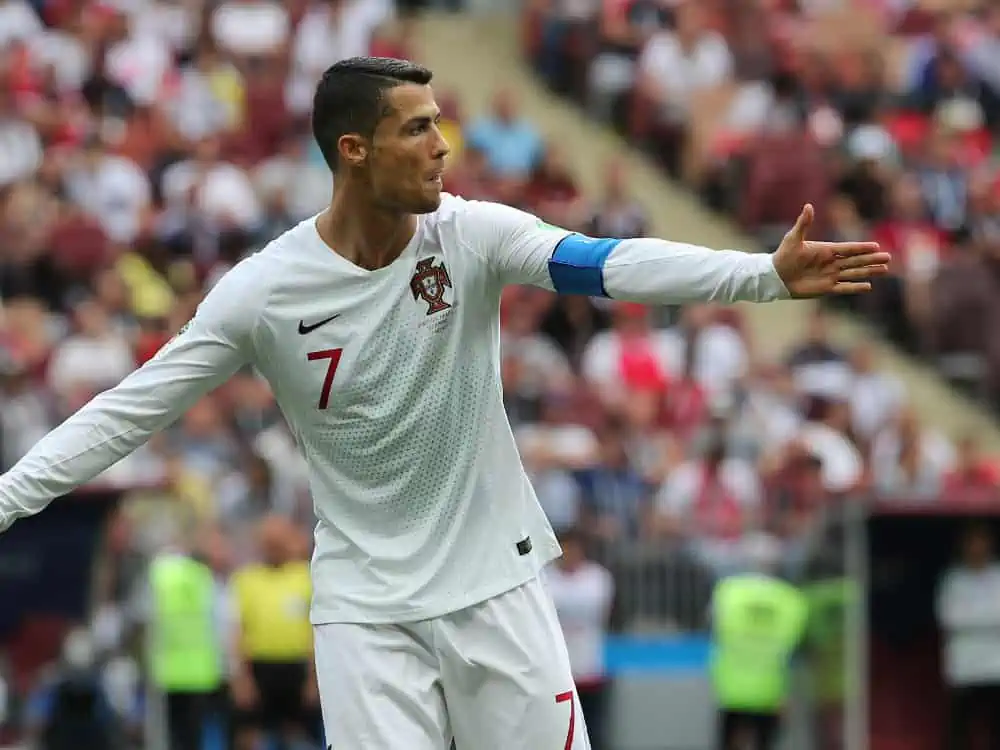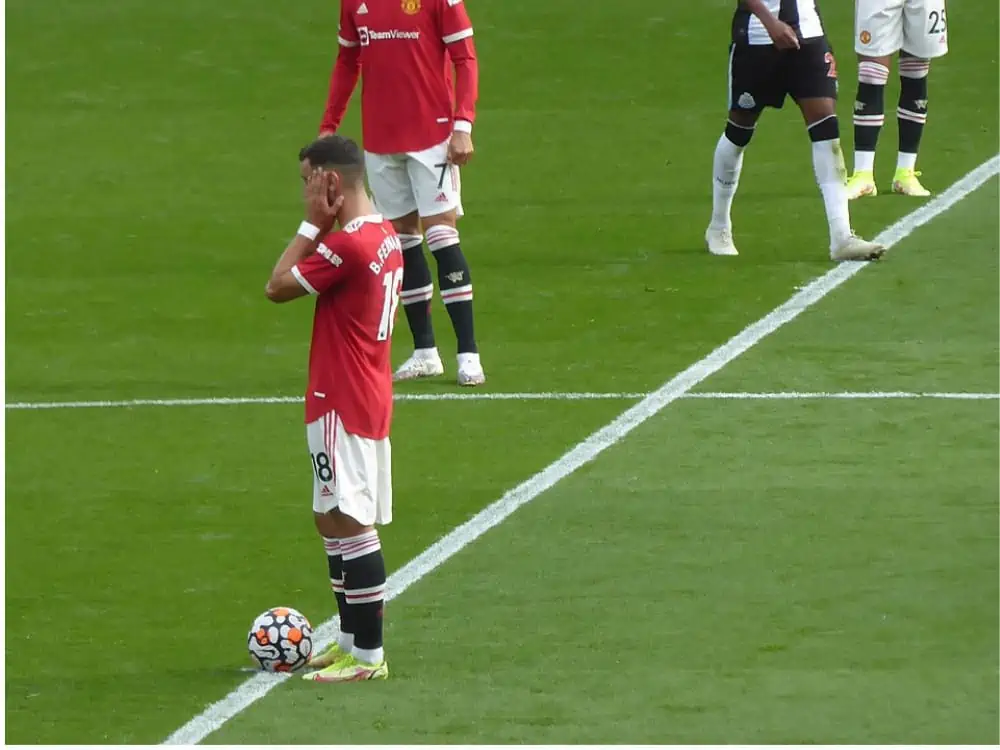Share the post "Striker Vs Center Forward (Only Goal Scorers?)"
If you’re a soccer fan, you’ve probably heard people discuss strikers and center forwards like they are the same thing. You might be surprised to hear that, while similar, these positions are quite different.
Strikers are goal-scoring machines, looking to find the back of the net at every opportunity. Center forwards are facilitators, often setting up strikers and creating chances for teammates.
Next, we’re going to break down both positions and discuss the subtle differences that make them unique. We’ll also take a look at the influence of video games on how fans learn about soccer positions. The main areas of focus include:
- What is a striker?
- What is a center forward?
- Tactical attacking styles
- How video games have influenced the game

The Striker
The striker plays in more advanced positions than any other player on the team. Although some teams play with two strikers, most modern formations involve one out-and-out striker, with other attackers surrounding them.
The striker is typically the primary goal threat for a team and is often afforded total freedom of movement to be as effective as possible.
There are many different types of strikers in soccer. Depending on the size, athleticism, and skill level of the player, they may adopt a certain style. Large, physical strikers, like Romelu Lukaku, rely on their strength and speed to pin defenders, sprint past opponents and compete for crosses.
Shorter strikers like Sergio Aguero, use pace, agility, dribbling skills, and positioning to get into goalscoring positions.
As we’ve seen with the likes of Radamel Falcao, height isn’t everything when it comes to scoring with your head. Soccer players, and in particular, strikers, can be effective regardless of their size.
When you combine size, skill, athleticism, and natural talent, you get the best strikers in the world. In the modern game, we have a handful of truly elite all-around strikers that bring a little bit of everything to the table, such as Cristiano Ronaldo, Karim Benzema, and Kylian Mbappe.
Striker and Center Forward FAQs
What Is the Role of a Striker in Soccer?
The main role of most strikers in soccer is to score goals. Most strikers are judged on their goal contributions. We often witness some of the best strikers in the world play poorly for an entire game but manage to score two important goals, helping their team win. In many cases, a striker has a good day at the office if they manage to put the ball in the back of the net.
However, strikers also have other roles. They must be available to receive the ball from midfielders while under pressure from defenders. Strikers are responsible for holding off defenders and linking the play with wingers, center forwards, and midfielders.
In some teams, strikers must also be an outlet or long ball option. This means they must be available to either flick on long passes from defenders, control the ball while surrounded by defenders, or make runs in behind the defense for an over-the-top pass.
| Rank | Player | Goals | Years Active |
| 1 | Cristiano Ronaldo | 807 | 2002 – present |
| 2 | Pelé | 765 | 1957 – 1977 |
| 3 | Lionel Messi | 758 | 2004 – present |
| 4 | Romario | 753 | 1985 – 2007 |
| 5 | Ferenc Puskás | 729 | 1943 – 1966 |
| 6 | Josef Bican | 720 | 1931 – 1955 |
| 7 | Jimmy Jones | 647 | 1947 – 1964 |
| 8 | Gerd Muller | 634 | 1964 – 1981 |
| 9 | Eusébio | 622 | 1958 – 1981 |
| 10 | Joe Bambrick | 616 | 1926 – 1943 |
| 11 | Glenn Ferguson | 562 | 1987 – 2011 |
| 12 | Zlatan Ibrahimovic | 559 | 1999 – present |
The Center Forward
The term center forward is often used incorrectly to describe a striker. A center forward plays mainly between the lines, meaning they occupy half positions, between the midfield and attack.
While a striker does a lot of work off the ball, making runs behind the defense or into the penalty box, a center forward is generally more effective with the ball at his or her feet.
Rather than sprinting away from the ball, looking for a goalbound pass, the center forward moves toward the ball to gain possession. A center forward is usually one of the team’s main creative outlets, using their first touch, dribbling, and movement to create space in the opposition territory.
As a productive attacker, a center forward is constantly trying to find ways to create goal-scoring attacks, through passing, quick one-twos, dribbling, or shooting themselves.
Some center forwards also have defensive duties, dropping into midfield when the opposition is in possession. If a team sets out with very defensive tactics, the center forward will often man-mark the center defensive midfielder of the opposition team.
What Does a Center Forward Do?
One of the key differences between a center forward and a striker is what they are expected to contribute to the team. Although a striker may have some specific tactical instructions, their main responsibility is to score goals. A center forward generally has a broader set of responsibilities, such as:
- Chance creation
- Breaking defensive lines
- Dictating the tempo of the game
- Switching the play
- Defending the opposition midfield
- Pressing
- Scoring
Some of the best center forwards in today’s game are:
- Lionel Messi
- Harry Kane
- Kai Havertz
- Kevin DeBruyne
- Bruno Fernandes

The Tactical Decisions
Many teams play with a center forward and a striker. However, this isn’t always the case. Let’s take a look at why a team might start with different types of attacking players.
Center Forward vs Striker
If a coach has to choose between a center forward or a striker, he or she will almost always select a striker. A team that plays with a center forward but no striker is likely to lack balance.
With no attacking focal point, they may not be able to create goal-scoring chances or penetrating plays.
However, in an extremely defensive setup, a team could work effectively without a striker, using the extra midfielder or defender to plug any potential holes in the defense. This tactical style would rely on counterattacks to create chances.
It is common for teams to play without a center forward. Instead, they use wingers to create goalscoring opportunities or add an extra midfielder to dominate possession.
Center Forward vs False 9
The false 9 position has evolved in recent years as an effective tactic for teams with high-scoring wingers. A false 9 essentially operates as a hybrid player, somewhere between a striker and a center forward. He or she is usually the best playmaker on the team. False 9s are typically highly skilled and intelligent players.
They have excellent movement, creating pockets of space to evade defenders and pick up possession.
Effective false 9s must also be adept creators, bringing teammates into play and setting up goals directly. Teams generally don’t play every game with a false 9. It is usually a tactical option that they deploy in certain games. However, Liverpool, Manchester City, and Barcelona have used false 9s to great effect in the past decade.
Some notable players that have done awesome jobs in the false 9 position include:
- Roberto Firmino
- Kevin DeBruyne
- Lionel Messi
- Cesc Fabregas
- Paulo Dybala
Unsurprisingly, Messi is one of the best to ever play in the false 9.
The Influence of Video Games On Soccer
Soccer video games have helped grow the sport over the past two decades. While it has long been the biggest sport in the world, it lagged considerably behind the likes of American football, basketball, and baseball in the United States. Video games help players gain a better understanding of the sport without actually playing it.
They must become aware of player roles, positioning, attacking, defending, and tactics. Since each video game character is awarded points for their attributes, gamers can study the types of abilities that players in certain positions have.
What’s more, in some video games, selecting players in the wrong position can weaken their abilities in-game. Therefore, causal gamers must learn to differentiate between a winger and a midfielder, a left full-back and a left wing-back, or a center forward and a striker.
Scouting Reports
Soccer video games are not just for fans. Many professionals spend their time off playing FIFA, Pro Evolution Soccer, and Football Manager. In a recent New York Times article, former Arsenal winger, Alex Iwobi, admitted to using FIFA as a scouting tool for his opponents.
The Everton attacker claimed to research his opponents in the game to analyze their strengths and weaknesses.
The Italian World Cup-winning maestro, Andrea Pirlo, famously spoke about playing video games on the day of the 2006 World Cup final:
“I don’t feel pressure… I don’t give a toss about it. I spent the afternoon of Sunday, 9 July, 2006 in Berlin sleeping and playing the PlayStation. In the evening, I went out and won the World Cup.”
Center Forward Vs Striker FIFA 21
In the FIFA video game franchise, players set up their teams just like in the real sport, with several formation options. Center forwards typically play behind the striker and link with the midfielders.
Players can modify each position, giving their center forward specific tactical instructions. For example, they can instruct them to drop deep into the midfield to get open for passes, or they can force them to stay up top and play close to the striker.
In the FIFA games, the striker is the furthermost attacker and is responsible for scoring a lot of the goals. Although most formations use a striker, not all of them have a center forward.
What’s the Difference Between ST and CF?
In video games, the names of positions are often shortened for a clearer visual effect. ST stands for ‘striker’, while CF stands for ‘center forward’.
Where Is CF In FIFA?
The CF in a FIFA team is usually just behind the striker or in front of the midfield. However, if you’re wondering why certain teams don’t have the option of a CF, it’s likely to be down to the formation you have selected.
Many formations don’t use a CF, often electing for a center attacking midfielder (CAM) or a three-player midfield instead. However, you can change the formation of your team to incorporate a center forward.
Share the post "Striker Vs Center Forward (Only Goal Scorers?)"
Joel is a seasoned soccer journalist and analyst with many years of experience in the field. Joel specializes in game analysis, player profiles, transfer news, and has a keen eye for the tactical nuances of the game. He played at various levels in the game and coached teams - he is happy to share his insight with you.



